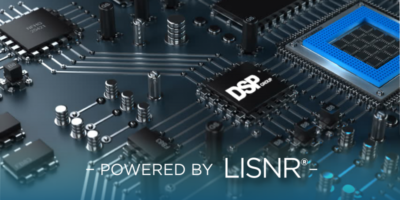DSP Group and LISNR create low power audio-enabled data transmission
Two companies, wireless chipset developer, DSP Group, and LISNR, which provides data-over-audio technology, have collaborated to create the Audio-D, a device which supports data-over-audio communication for any device with a speaker or microphone.
Audio-D is based on DSP Group’s DBMD4 Voice SoC and LISNR technology. It is designed to overcome device-to-device hardware restraints regarding radio frequency (RF) protocols, explains DSP Group. This enables always-on communication and a high level of interoperability while consuming little power.
Over the past 20 years, the connected industry has made significant advancements in connecting devices from afar, continues DSP Group. In that same time it’s become increasingly difficult to facilitate an initial or always-on connection to devices in close proximity, due to hardware and RF limitations. Short-range wireless device detection and data transmission across all connected devices can be quite difficult using the current methods or protocols, continues DSP Group.
According to the companies, the co-operation of DSP Group and LISNR solves these hurdles and creates a device that enables any device manufacturer to leverage audio as a means to transmit data across devices. Using DSP Group’s DBMD4, a cost-effective, small form factor voice processor, voice processing in internet of things (IoT) devices is possible, while maintaining low power consumption. LISNR technology serves as an audio data transfer software to address connectivity issues. It identifies a device in close proximity to another, and then initiates any secondary action. Secondary action could be connectivity, authentication for access, payment, ID, pairing, syncing, or data transmission such as mesh networking across all devices.
The Audio-D is characterised by interoperability allowing a variety of devices to be mixed and matched to meet the needs of the project.
Devices with a microphone, speaker, and Audio-D will be able to use sound to detect and directly communicate with any other device in the vicinity, regardless of manufacturer, assures DSP Group. Target applications are in the automotive, consumer electronics, hospitality, smart cities and healthcare.
LISNR’s proprietary, near-ultrasonic protocol sends data over audio across bandwidths (12 to 19khz) that are audible or inaudible, depending on use case and distribution method, to ensure optimal performance. Additional performance enhancements include Smart Tone types (ID, text, data), that optimise characteristics of data type for the use case.




